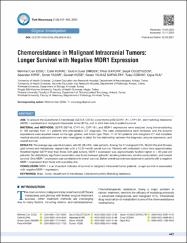Chemoresistance in Malignant Intracranial Tumors: Longer Survival with Negative MDR1 Expression

Göster/
Tarih
2021Yazar
Ezgu, Mehmet CanKural, Cahit
Şimsek, Gülçin Güler
Kaygın, Pınar
Oğuztüzun, Serpil
Kırık, Alparslan
Yaşar, Soner
Köse, Gülşah
Üst veri
Tüm öğe kaydını gösterKünye
Ezgu MC, Kural C, Simsek GG, Kaygin P, Oguztuzun S, Kirik A, Yasar S, Kose G, Sarialtin SY, Coban T, Kul O. Chemoresistance in Malignant Intracranial Tumors: Longer Survival with Negative MDR1 Expression. Turk Neurosurg. 2021;31(3):447-459. doi: 10.5137/1019-5149.JTN.29819-20.3. PMID: 33978213.Özet
AIM: To analyze the Glutathione S-transferase (GST)-P, GST-M, cytochrome p450 (CYP)1-A1, CYP1-B1, and multidrug resistance (MDR)-1 expressions in malignant intracranial tumor (ICT)s, and to elicit their role on patient survival.
MATERIAL and METHODS: GST-P, GST-M, CYP1-A1, CYP1-B1, and MDR-1 expressions were analyzed using immunostaining in 149 samples from 141 patients with preoperative ICT diagnosis. The case characteristics were reviewed, and the enzyme expressions were equated based on the age, gender, and tumor type. Then, 77 of 141 patients with malignant ICT and complete medical records postoperative were also investigated in detail for the relationship between the diagnosis, enzyme expression, and overall survival.
RESULTS: The average age was 49.44 years, with 83 (58.45%) male patients. Among the 77 malignant ICTs, 38 (49.3%) and 29 were glial tumors and metastases, respectively, with a 13.35-month overall survival. Patients with metastatic tumor have approximately threefold higher GSTP level than those with glial tumors. MDR-1 expression was approximately twofold higher in > 60-year-old patients. No statistically significant association was found between patients' smoking behaviors, alcohol consumption, and overall survival. Only MDR-1 expression was correlated with overall survival. Better overall survival was observed in patients with a negative MDR-1 expression than those with a positive one.

















